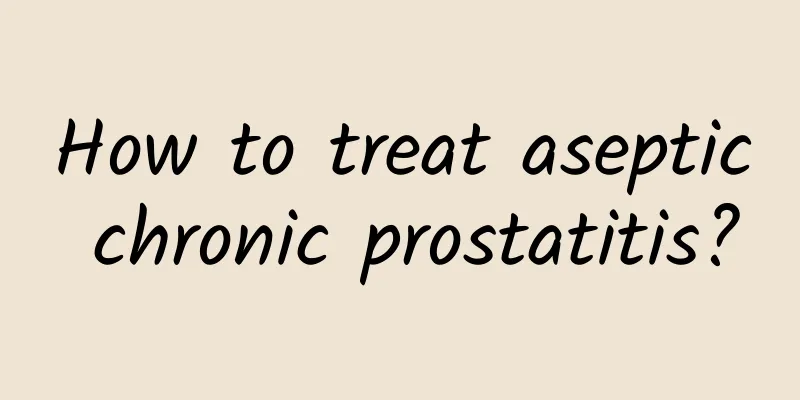How to treat aseptic chronic prostatitis?

|
Although aseptic chronic prostatitis does not involve bacterial infection, the absence of bacteria does not mean that there are no other pathogenic microorganisms, such as parasites, etc. Therefore, patients will feel some abnormalities in their bodies at the beginning, and their prostate may feel some pain. So let us understand together how to treat aseptic chronic prostatitis! The treatment goals of chronic prostatitis are mainly to relieve pain, improve urination symptoms and improve quality of life. The evaluation of treatment efficacy should be based mainly on symptom improvement. 1. General treatment Health education, psychological and behavioral counseling have a positive effect. Patients should abstain from alcohol, spicy food, hold urine, sit for long periods of time, keep warm, and strengthen physical exercise. 2. Drug treatment The most commonly used drugs are antibiotics, α-receptor blockers, herbal preparations and non-steroidal anti-inflammatory analgesics. Other drugs also have varying degrees of effectiveness in relieving symptoms. (1) Antibiotics: Currently, in the clinical practice of treating prostatitis, the most commonly used first-line drug is antibiotics, but only about 5% of patients with chronic prostatitis have clear bacterial infection. Chronic bacterial prostatitis: antibiotics are selected based on bacterial culture results and the ability of the drug to penetrate the prostate. After prostatitis is confirmed, the course of antibiotic treatment is 4 to 6 weeks, during which the patient should undergo periodic efficacy evaluation. Intraprostatic injection of antibiotics is not recommended. Chronic nonbacterial prostatitis: Antibiotic treatment is mostly empirical treatment, and the theoretical basis is to speculate that certain pathogens that are negative in routine culture cause the occurrence of this type of inflammation. Therefore, it is recommended to take oral antibiotics such as fluoroquinolone for 2 to 4 weeks, and then decide whether to continue antibiotic treatment based on the feedback of the efficacy. Only when the clinical symptoms are indeed alleviated, it is recommended to continue the use of antibiotics. The recommended total course of treatment is 4 to 6 weeks. (2) α-receptor blockers: α-receptor blockers can relax the smooth muscles of the prostate and bladder and improve lower urinary tract symptoms and pain, thus becoming a basic drug for the treatment of type II/type III prostatitis. Different α-receptor blockers can be selected according to the patient's condition. The recommended α-receptor blockers are: doxazosin, naftopidil, tamsulosin and terazosin. The results of controlled studies show that the above drugs have different degrees of improvement on patients' urination symptoms, pain and quality of life index. The above article introduces in detail how to treat aseptic chronic prostatitis. Most patients still need some general treatment, so at the beginning, you must pay attention to keeping warm. Patients must quit smoking and drinking, but they cannot hold urine for a long time or sit for a long time. |
<<: Treatment of aseptic chronic prostatitis
>>: Can aseptic chronic prostatitis be cured?
Recommend
What causes a bloated belly in men?
What is the cause of male bloating? I believe thi...
Why don't I have morning erections anymore?
The erection of male reproductive organs is cause...
What are the conservative treatments for impotence and premature ejaculation?
Impotence and premature ejaculation problems trou...
Thin penis root
A short penis can easily lead to a strong sense o...
Sexual needs of men around 35
Both men and women have sexual needs, and general...
What are the symptoms of my husband's kidney deficiency?
Sometimes the symptoms of kidney deficiency are n...
What is the disease of dizziness and tinnitus in men
Nowadays, more and more people are suffering from...
Can saw palmetto cure prostatitis?
Prostatitis is a common disease among men. Suffer...
Is ginger beer beer? How to make ginger beer
I'm afraid everyone is unfamiliar with beer. ...
What should we pay attention to when testing male sex hormones?
The normal functioning of each person's organ...
How to read men's eyebrows
I wonder if you have ever heard of the phrase &qu...
What should I do if my lower body is a little itchy? What are the reasons?
For many men, their lower body becomes itchy, whi...
Vulvar vascular bulge
The penis of men is the most vulnerable part of t...
How to reduce armpit fat, a few tips to easily reduce fat
Everyone knows that the armpit muscles are seldom...
What are the benefits of lemon wolfberry chrysanthemum tea for men?
Lemonade"text-indent: 2em; text-align: left;&...









